History Essay: Analyzing War, Revolution, and Civilian Impact
VerifiedAdded on 2022/08/21
|8
|1924
|9
Essay
AI Summary
This essay critically analyzes the chapter 'The Strains of Mobilization' from the book 'The Shock of War: Civilian Experiences, 1937-1945,' focusing on the Second World War's impact on civilians. It explores the economic and social consequences of war, including wartime production, labor laws, and propaganda. The essay also examines the role of countries like the United States and Canada in the war, the involvement of Asian countries, and the Japanese attack on Pearl Harbor. Part Two of the essay uses a primary source to analyze the history of Nazi Germany, highlighting internal conflicts, lack of trust in leadership, and the impact of war on the German society. The essay discusses the challenges faced by civilians, the rise of black markets, and the lack of social security, offering a comprehensive overview of the historical context and its effects on people's lives.
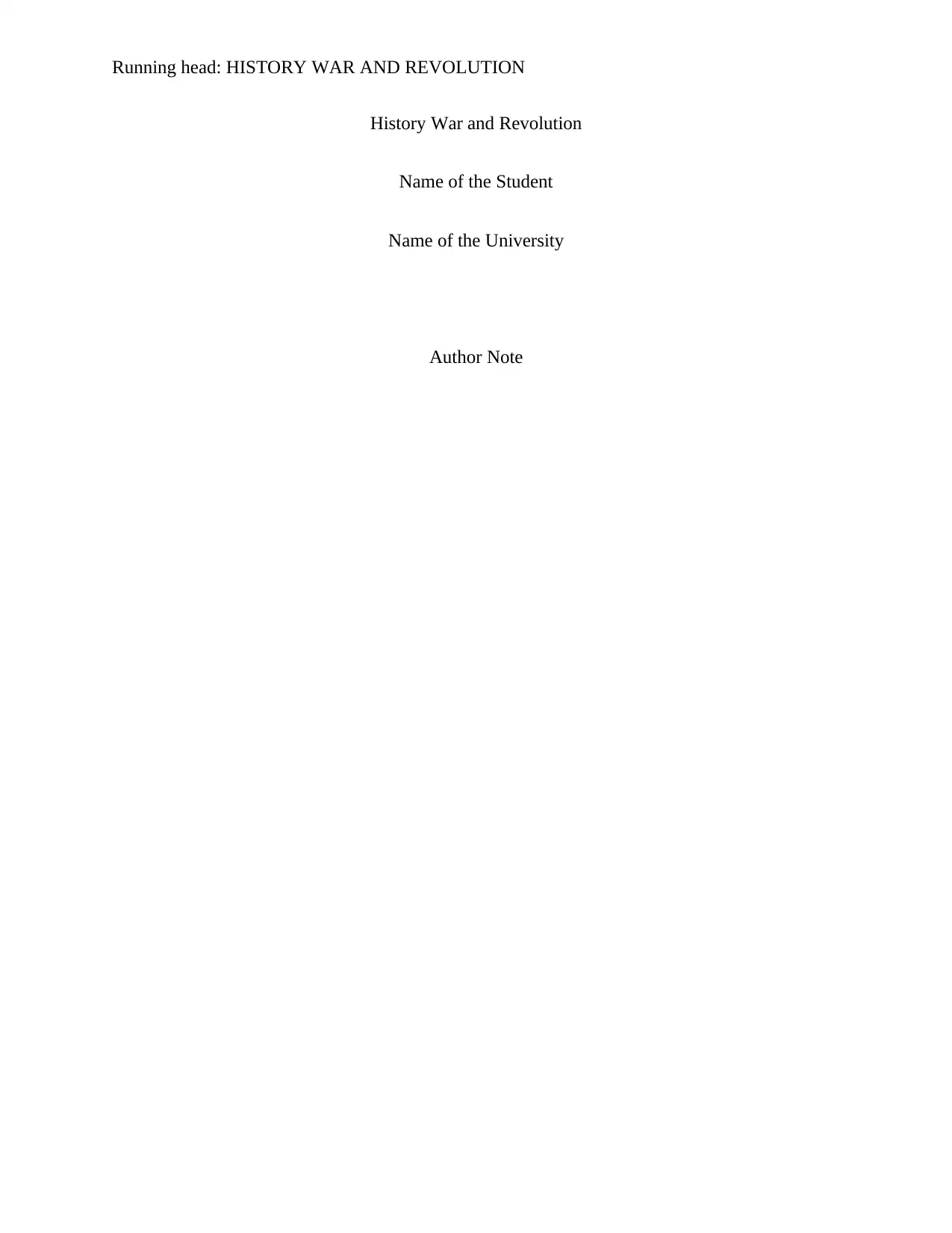
Running head: HISTORY WAR AND REVOLUTION
History War and Revolution
Name of the Student
Name of the University
Author Note
History War and Revolution
Name of the Student
Name of the University
Author Note
Paraphrase This Document
Need a fresh take? Get an instant paraphrase of this document with our AI Paraphraser
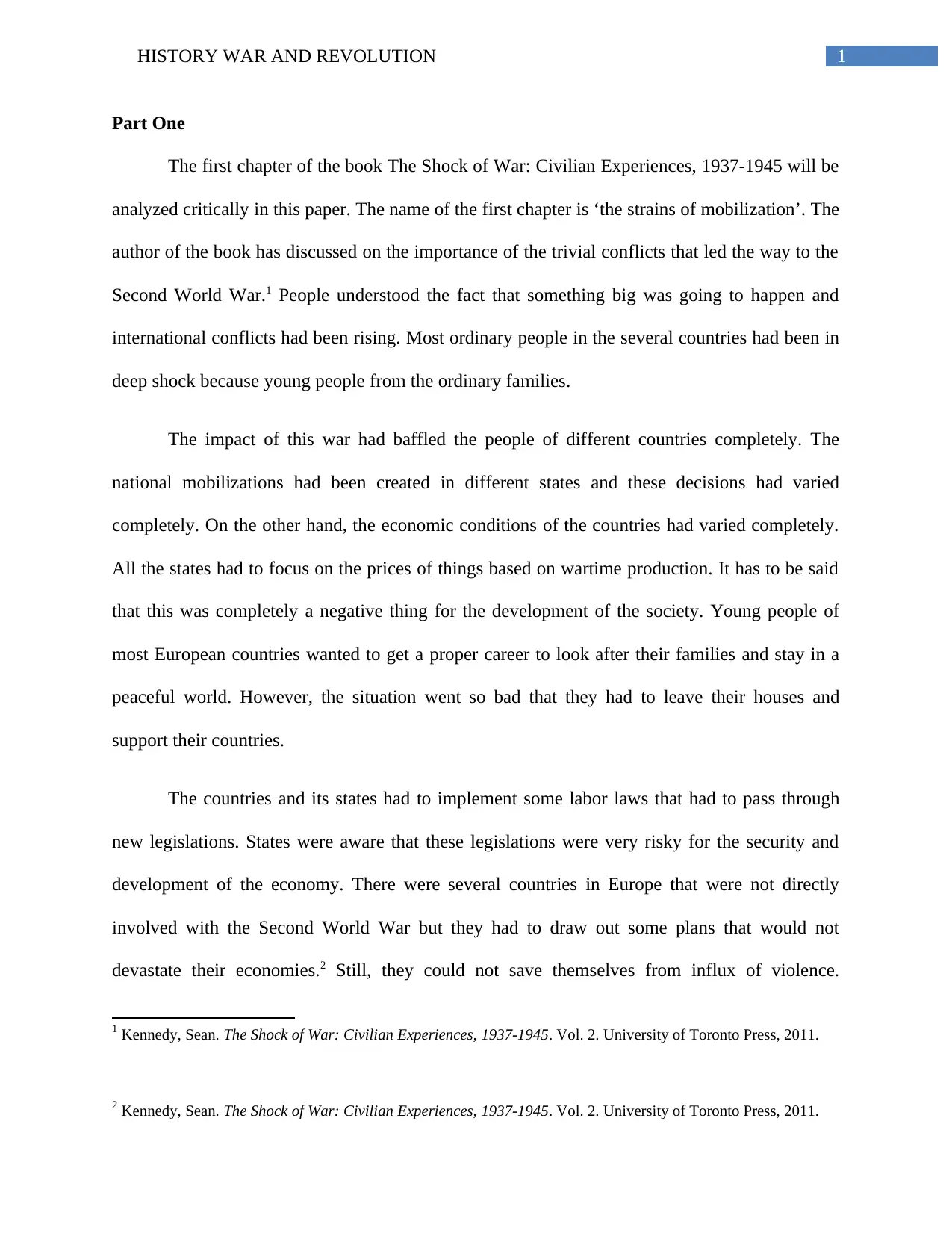
1HISTORY WAR AND REVOLUTION
Part One
The first chapter of the book The Shock of War: Civilian Experiences, 1937-1945 will be
analyzed critically in this paper. The name of the first chapter is ‘the strains of mobilization’. The
author of the book has discussed on the importance of the trivial conflicts that led the way to the
Second World War.1 People understood the fact that something big was going to happen and
international conflicts had been rising. Most ordinary people in the several countries had been in
deep shock because young people from the ordinary families.
The impact of this war had baffled the people of different countries completely. The
national mobilizations had been created in different states and these decisions had varied
completely. On the other hand, the economic conditions of the countries had varied completely.
All the states had to focus on the prices of things based on wartime production. It has to be said
that this was completely a negative thing for the development of the society. Young people of
most European countries wanted to get a proper career to look after their families and stay in a
peaceful world. However, the situation went so bad that they had to leave their houses and
support their countries.
The countries and its states had to implement some labor laws that had to pass through
new legislations. States were aware that these legislations were very risky for the security and
development of the economy. There were several countries in Europe that were not directly
involved with the Second World War but they had to draw out some plans that would not
devastate their economies.2 Still, they could not save themselves from influx of violence.
1 Kennedy, Sean. The Shock of War: Civilian Experiences, 1937-1945. Vol. 2. University of Toronto Press, 2011.
2 Kennedy, Sean. The Shock of War: Civilian Experiences, 1937-1945. Vol. 2. University of Toronto Press, 2011.
Part One
The first chapter of the book The Shock of War: Civilian Experiences, 1937-1945 will be
analyzed critically in this paper. The name of the first chapter is ‘the strains of mobilization’. The
author of the book has discussed on the importance of the trivial conflicts that led the way to the
Second World War.1 People understood the fact that something big was going to happen and
international conflicts had been rising. Most ordinary people in the several countries had been in
deep shock because young people from the ordinary families.
The impact of this war had baffled the people of different countries completely. The
national mobilizations had been created in different states and these decisions had varied
completely. On the other hand, the economic conditions of the countries had varied completely.
All the states had to focus on the prices of things based on wartime production. It has to be said
that this was completely a negative thing for the development of the society. Young people of
most European countries wanted to get a proper career to look after their families and stay in a
peaceful world. However, the situation went so bad that they had to leave their houses and
support their countries.
The countries and its states had to implement some labor laws that had to pass through
new legislations. States were aware that these legislations were very risky for the security and
development of the economy. There were several countries in Europe that were not directly
involved with the Second World War but they had to draw out some plans that would not
devastate their economies.2 Still, they could not save themselves from influx of violence.
1 Kennedy, Sean. The Shock of War: Civilian Experiences, 1937-1945. Vol. 2. University of Toronto Press, 2011.
2 Kennedy, Sean. The Shock of War: Civilian Experiences, 1937-1945. Vol. 2. University of Toronto Press, 2011.
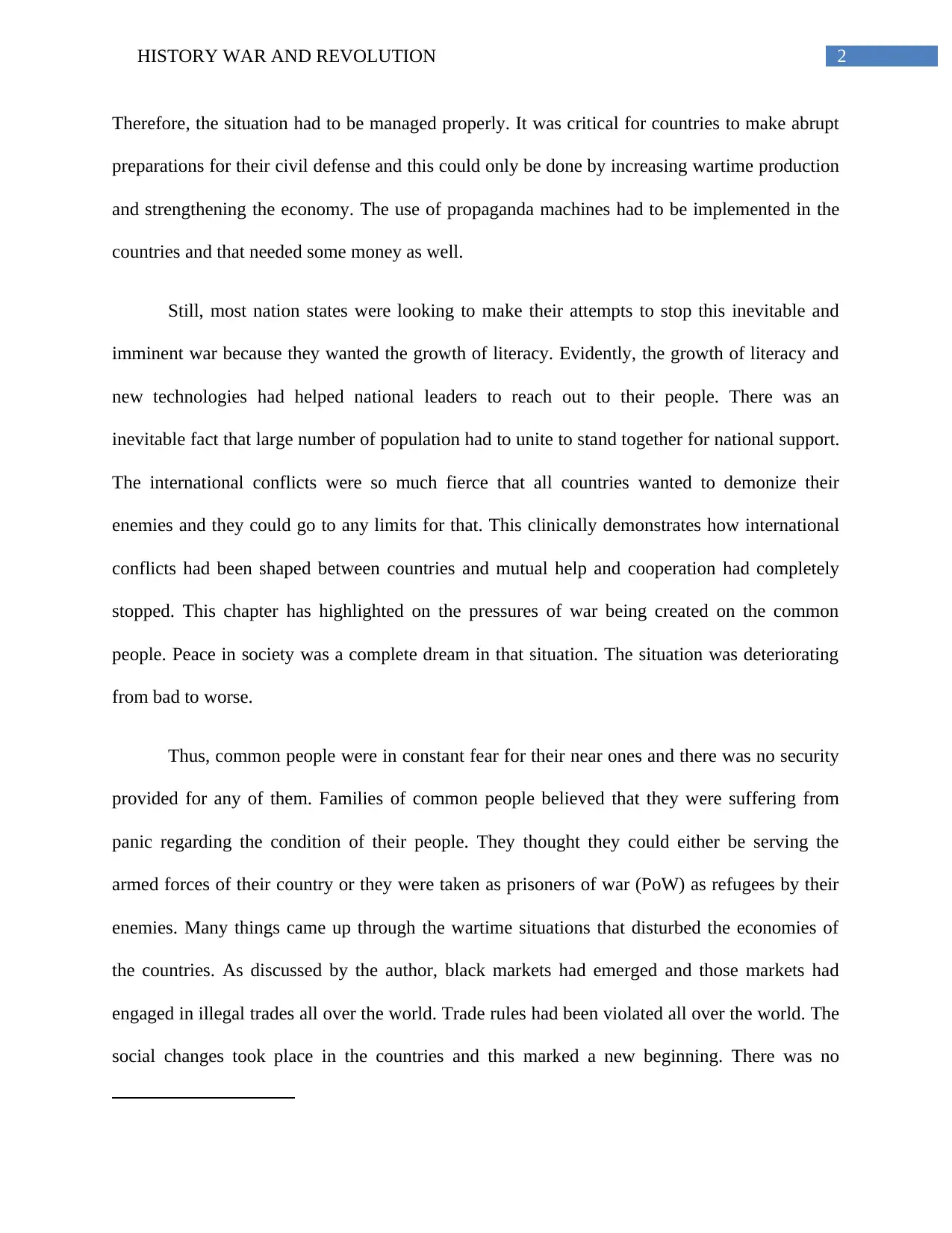
2HISTORY WAR AND REVOLUTION
Therefore, the situation had to be managed properly. It was critical for countries to make abrupt
preparations for their civil defense and this could only be done by increasing wartime production
and strengthening the economy. The use of propaganda machines had to be implemented in the
countries and that needed some money as well.
Still, most nation states were looking to make their attempts to stop this inevitable and
imminent war because they wanted the growth of literacy. Evidently, the growth of literacy and
new technologies had helped national leaders to reach out to their people. There was an
inevitable fact that large number of population had to unite to stand together for national support.
The international conflicts were so much fierce that all countries wanted to demonize their
enemies and they could go to any limits for that. This clinically demonstrates how international
conflicts had been shaped between countries and mutual help and cooperation had completely
stopped. This chapter has highlighted on the pressures of war being created on the common
people. Peace in society was a complete dream in that situation. The situation was deteriorating
from bad to worse.
Thus, common people were in constant fear for their near ones and there was no security
provided for any of them. Families of common people believed that they were suffering from
panic regarding the condition of their people. They thought they could either be serving the
armed forces of their country or they were taken as prisoners of war (PoW) as refugees by their
enemies. Many things came up through the wartime situations that disturbed the economies of
the countries. As discussed by the author, black markets had emerged and those markets had
engaged in illegal trades all over the world. Trade rules had been violated all over the world. The
social changes took place in the countries and this marked a new beginning. There was no
Therefore, the situation had to be managed properly. It was critical for countries to make abrupt
preparations for their civil defense and this could only be done by increasing wartime production
and strengthening the economy. The use of propaganda machines had to be implemented in the
countries and that needed some money as well.
Still, most nation states were looking to make their attempts to stop this inevitable and
imminent war because they wanted the growth of literacy. Evidently, the growth of literacy and
new technologies had helped national leaders to reach out to their people. There was an
inevitable fact that large number of population had to unite to stand together for national support.
The international conflicts were so much fierce that all countries wanted to demonize their
enemies and they could go to any limits for that. This clinically demonstrates how international
conflicts had been shaped between countries and mutual help and cooperation had completely
stopped. This chapter has highlighted on the pressures of war being created on the common
people. Peace in society was a complete dream in that situation. The situation was deteriorating
from bad to worse.
Thus, common people were in constant fear for their near ones and there was no security
provided for any of them. Families of common people believed that they were suffering from
panic regarding the condition of their people. They thought they could either be serving the
armed forces of their country or they were taken as prisoners of war (PoW) as refugees by their
enemies. Many things came up through the wartime situations that disturbed the economies of
the countries. As discussed by the author, black markets had emerged and those markets had
engaged in illegal trades all over the world. Trade rules had been violated all over the world. The
social changes took place in the countries and this marked a new beginning. There was no
⊘ This is a preview!⊘
Do you want full access?
Subscribe today to unlock all pages.

Trusted by 1+ million students worldwide
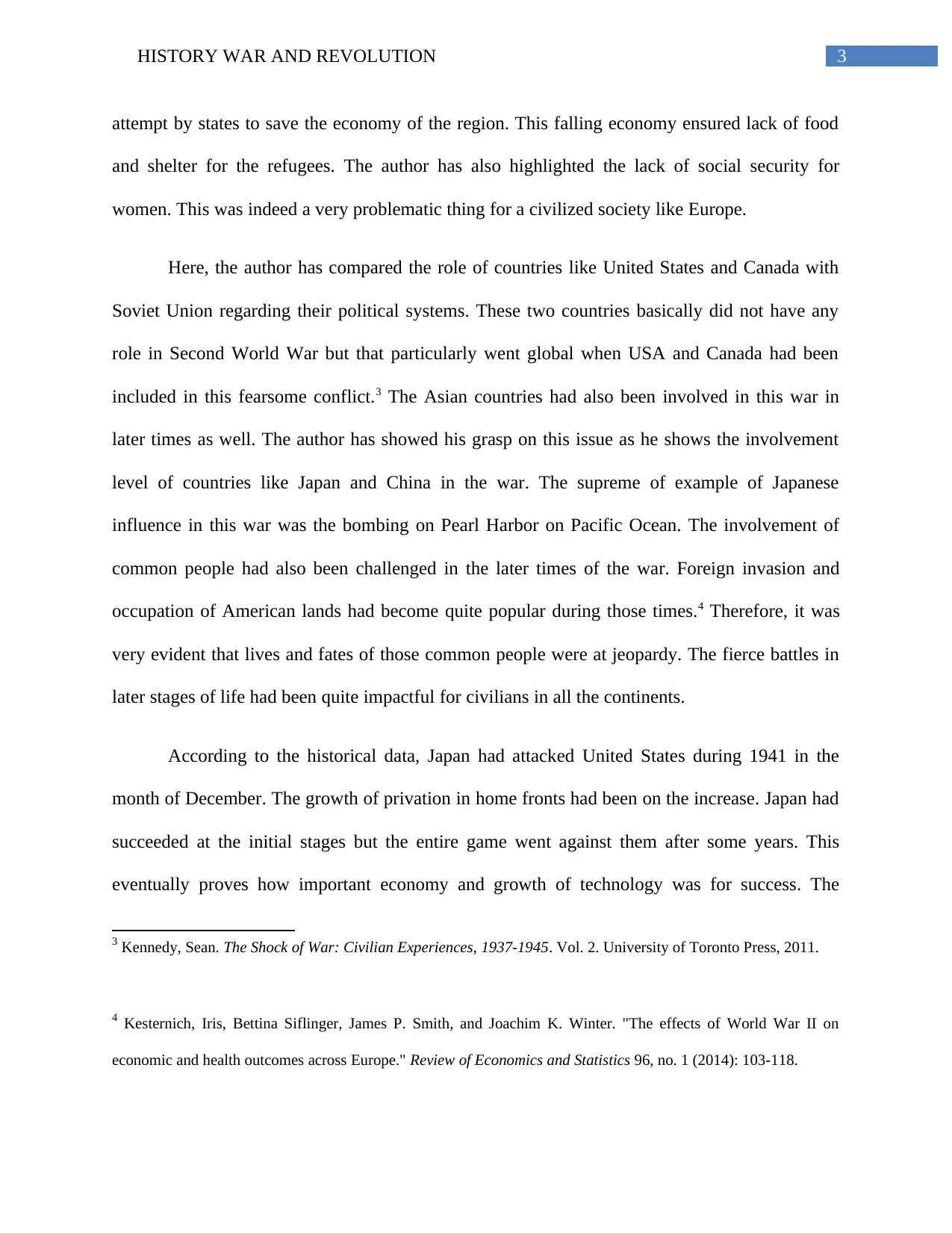
3HISTORY WAR AND REVOLUTION
attempt by states to save the economy of the region. This falling economy ensured lack of food
and shelter for the refugees. The author has also highlighted the lack of social security for
women. This was indeed a very problematic thing for a civilized society like Europe.
Here, the author has compared the role of countries like United States and Canada with
Soviet Union regarding their political systems. These two countries basically did not have any
role in Second World War but that particularly went global when USA and Canada had been
included in this fearsome conflict.3 The Asian countries had also been involved in this war in
later times as well. The author has showed his grasp on this issue as he shows the involvement
level of countries like Japan and China in the war. The supreme of example of Japanese
influence in this war was the bombing on Pearl Harbor on Pacific Ocean. The involvement of
common people had also been challenged in the later times of the war. Foreign invasion and
occupation of American lands had become quite popular during those times.4 Therefore, it was
very evident that lives and fates of those common people were at jeopardy. The fierce battles in
later stages of life had been quite impactful for civilians in all the continents.
According to the historical data, Japan had attacked United States during 1941 in the
month of December. The growth of privation in home fronts had been on the increase. Japan had
succeeded at the initial stages but the entire game went against them after some years. This
eventually proves how important economy and growth of technology was for success. The
3 Kennedy, Sean. The Shock of War: Civilian Experiences, 1937-1945. Vol. 2. University of Toronto Press, 2011.
4 Kesternich, Iris, Bettina Siflinger, James P. Smith, and Joachim K. Winter. "The effects of World War II on
economic and health outcomes across Europe." Review of Economics and Statistics 96, no. 1 (2014): 103-118.
attempt by states to save the economy of the region. This falling economy ensured lack of food
and shelter for the refugees. The author has also highlighted the lack of social security for
women. This was indeed a very problematic thing for a civilized society like Europe.
Here, the author has compared the role of countries like United States and Canada with
Soviet Union regarding their political systems. These two countries basically did not have any
role in Second World War but that particularly went global when USA and Canada had been
included in this fearsome conflict.3 The Asian countries had also been involved in this war in
later times as well. The author has showed his grasp on this issue as he shows the involvement
level of countries like Japan and China in the war. The supreme of example of Japanese
influence in this war was the bombing on Pearl Harbor on Pacific Ocean. The involvement of
common people had also been challenged in the later times of the war. Foreign invasion and
occupation of American lands had become quite popular during those times.4 Therefore, it was
very evident that lives and fates of those common people were at jeopardy. The fierce battles in
later stages of life had been quite impactful for civilians in all the continents.
According to the historical data, Japan had attacked United States during 1941 in the
month of December. The growth of privation in home fronts had been on the increase. Japan had
succeeded at the initial stages but the entire game went against them after some years. This
eventually proves how important economy and growth of technology was for success. The
3 Kennedy, Sean. The Shock of War: Civilian Experiences, 1937-1945. Vol. 2. University of Toronto Press, 2011.
4 Kesternich, Iris, Bettina Siflinger, James P. Smith, and Joachim K. Winter. "The effects of World War II on
economic and health outcomes across Europe." Review of Economics and Statistics 96, no. 1 (2014): 103-118.
Paraphrase This Document
Need a fresh take? Get an instant paraphrase of this document with our AI Paraphraser
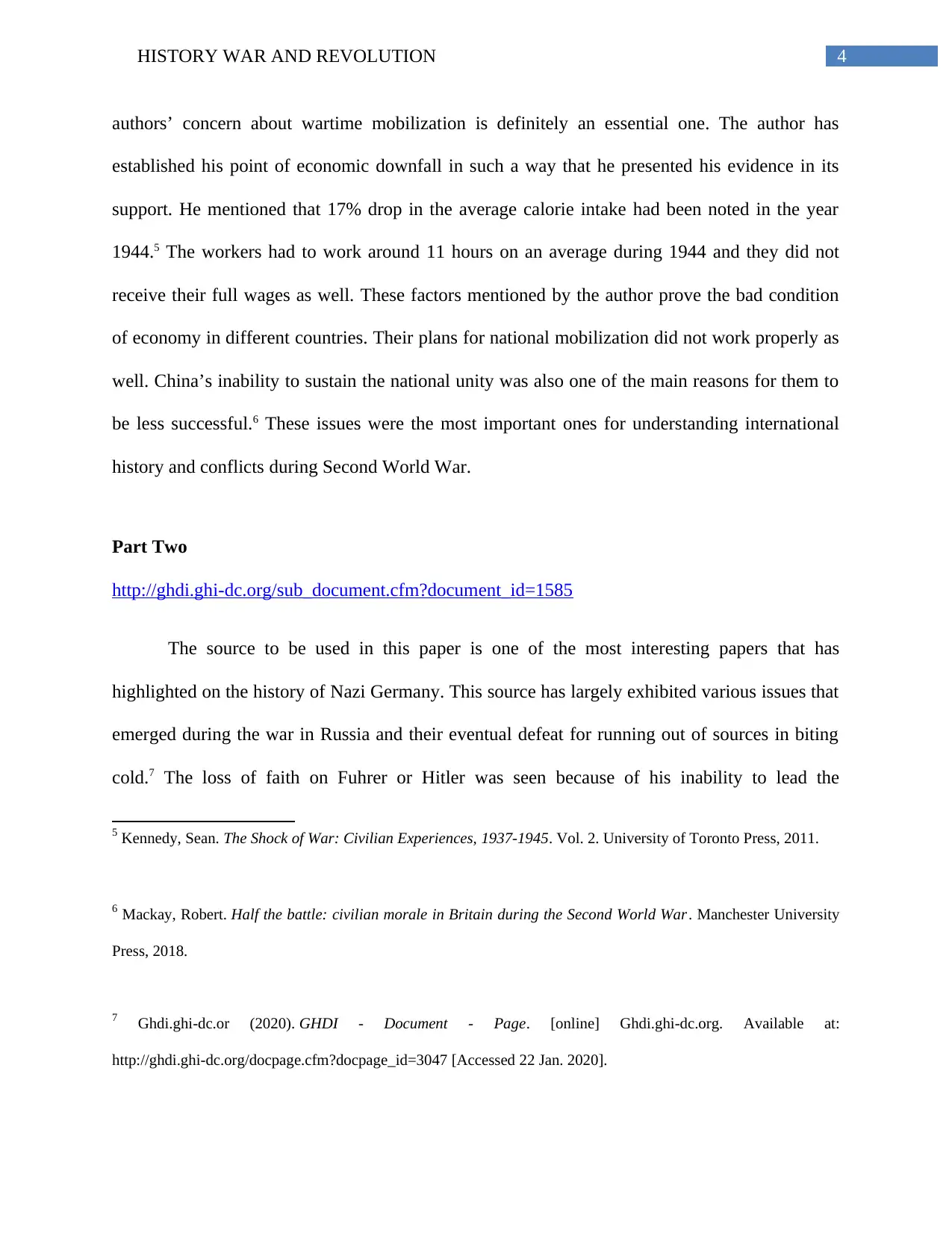
4HISTORY WAR AND REVOLUTION
authors’ concern about wartime mobilization is definitely an essential one. The author has
established his point of economic downfall in such a way that he presented his evidence in its
support. He mentioned that 17% drop in the average calorie intake had been noted in the year
1944.5 The workers had to work around 11 hours on an average during 1944 and they did not
receive their full wages as well. These factors mentioned by the author prove the bad condition
of economy in different countries. Their plans for national mobilization did not work properly as
well. China’s inability to sustain the national unity was also one of the main reasons for them to
be less successful.6 These issues were the most important ones for understanding international
history and conflicts during Second World War.
Part Two
http://ghdi.ghi-dc.org/sub_document.cfm?document_id=1585
The source to be used in this paper is one of the most interesting papers that has
highlighted on the history of Nazi Germany. This source has largely exhibited various issues that
emerged during the war in Russia and their eventual defeat for running out of sources in biting
cold.7 The loss of faith on Fuhrer or Hitler was seen because of his inability to lead the
5 Kennedy, Sean. The Shock of War: Civilian Experiences, 1937-1945. Vol. 2. University of Toronto Press, 2011.
6 Mackay, Robert. Half the battle: civilian morale in Britain during the Second World War. Manchester University
Press, 2018.
7 Ghdi.ghi-dc.or (2020). GHDI - Document - Page. [online] Ghdi.ghi-dc.org. Available at:
http://ghdi.ghi-dc.org/docpage.cfm?docpage_id=3047 [Accessed 22 Jan. 2020].
authors’ concern about wartime mobilization is definitely an essential one. The author has
established his point of economic downfall in such a way that he presented his evidence in its
support. He mentioned that 17% drop in the average calorie intake had been noted in the year
1944.5 The workers had to work around 11 hours on an average during 1944 and they did not
receive their full wages as well. These factors mentioned by the author prove the bad condition
of economy in different countries. Their plans for national mobilization did not work properly as
well. China’s inability to sustain the national unity was also one of the main reasons for them to
be less successful.6 These issues were the most important ones for understanding international
history and conflicts during Second World War.
Part Two
http://ghdi.ghi-dc.org/sub_document.cfm?document_id=1585
The source to be used in this paper is one of the most interesting papers that has
highlighted on the history of Nazi Germany. This source has largely exhibited various issues that
emerged during the war in Russia and their eventual defeat for running out of sources in biting
cold.7 The loss of faith on Fuhrer or Hitler was seen because of his inability to lead the
5 Kennedy, Sean. The Shock of War: Civilian Experiences, 1937-1945. Vol. 2. University of Toronto Press, 2011.
6 Mackay, Robert. Half the battle: civilian morale in Britain during the Second World War. Manchester University
Press, 2018.
7 Ghdi.ghi-dc.or (2020). GHDI - Document - Page. [online] Ghdi.ghi-dc.org. Available at:
http://ghdi.ghi-dc.org/docpage.cfm?docpage_id=3047 [Accessed 22 Jan. 2020].
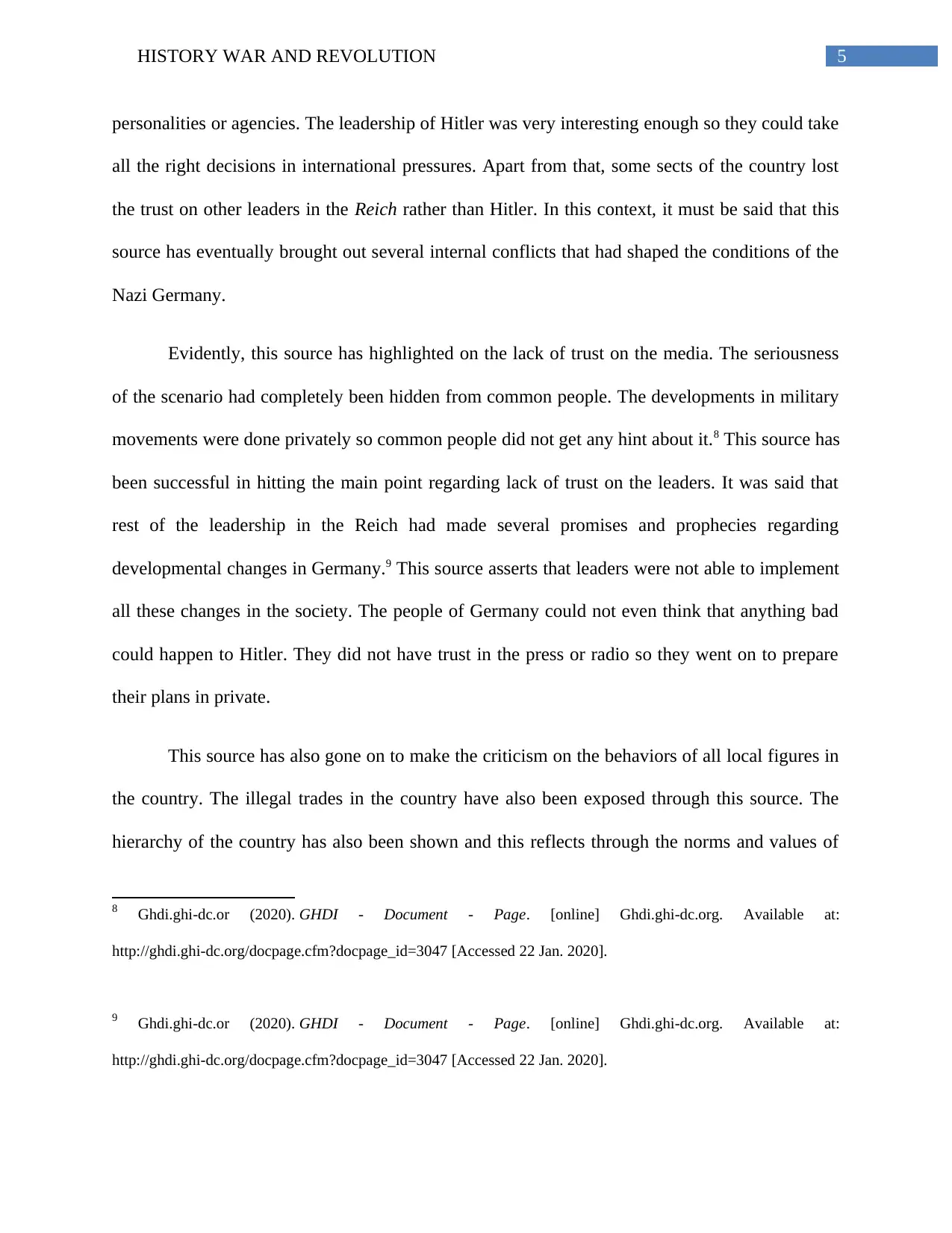
5HISTORY WAR AND REVOLUTION
personalities or agencies. The leadership of Hitler was very interesting enough so they could take
all the right decisions in international pressures. Apart from that, some sects of the country lost
the trust on other leaders in the Reich rather than Hitler. In this context, it must be said that this
source has eventually brought out several internal conflicts that had shaped the conditions of the
Nazi Germany.
Evidently, this source has highlighted on the lack of trust on the media. The seriousness
of the scenario had completely been hidden from common people. The developments in military
movements were done privately so common people did not get any hint about it.8 This source has
been successful in hitting the main point regarding lack of trust on the leaders. It was said that
rest of the leadership in the Reich had made several promises and prophecies regarding
developmental changes in Germany.9 This source asserts that leaders were not able to implement
all these changes in the society. The people of Germany could not even think that anything bad
could happen to Hitler. They did not have trust in the press or radio so they went on to prepare
their plans in private.
This source has also gone on to make the criticism on the behaviors of all local figures in
the country. The illegal trades in the country have also been exposed through this source. The
hierarchy of the country has also been shown and this reflects through the norms and values of
8 Ghdi.ghi-dc.or (2020). GHDI - Document - Page. [online] Ghdi.ghi-dc.org. Available at:
http://ghdi.ghi-dc.org/docpage.cfm?docpage_id=3047 [Accessed 22 Jan. 2020].
9 Ghdi.ghi-dc.or (2020). GHDI - Document - Page. [online] Ghdi.ghi-dc.org. Available at:
http://ghdi.ghi-dc.org/docpage.cfm?docpage_id=3047 [Accessed 22 Jan. 2020].
personalities or agencies. The leadership of Hitler was very interesting enough so they could take
all the right decisions in international pressures. Apart from that, some sects of the country lost
the trust on other leaders in the Reich rather than Hitler. In this context, it must be said that this
source has eventually brought out several internal conflicts that had shaped the conditions of the
Nazi Germany.
Evidently, this source has highlighted on the lack of trust on the media. The seriousness
of the scenario had completely been hidden from common people. The developments in military
movements were done privately so common people did not get any hint about it.8 This source has
been successful in hitting the main point regarding lack of trust on the leaders. It was said that
rest of the leadership in the Reich had made several promises and prophecies regarding
developmental changes in Germany.9 This source asserts that leaders were not able to implement
all these changes in the society. The people of Germany could not even think that anything bad
could happen to Hitler. They did not have trust in the press or radio so they went on to prepare
their plans in private.
This source has also gone on to make the criticism on the behaviors of all local figures in
the country. The illegal trades in the country have also been exposed through this source. The
hierarchy of the country has also been shown and this reflects through the norms and values of
8 Ghdi.ghi-dc.or (2020). GHDI - Document - Page. [online] Ghdi.ghi-dc.org. Available at:
http://ghdi.ghi-dc.org/docpage.cfm?docpage_id=3047 [Accessed 22 Jan. 2020].
9 Ghdi.ghi-dc.or (2020). GHDI - Document - Page. [online] Ghdi.ghi-dc.org. Available at:
http://ghdi.ghi-dc.org/docpage.cfm?docpage_id=3047 [Accessed 22 Jan. 2020].
⊘ This is a preview!⊘
Do you want full access?
Subscribe today to unlock all pages.

Trusted by 1+ million students worldwide
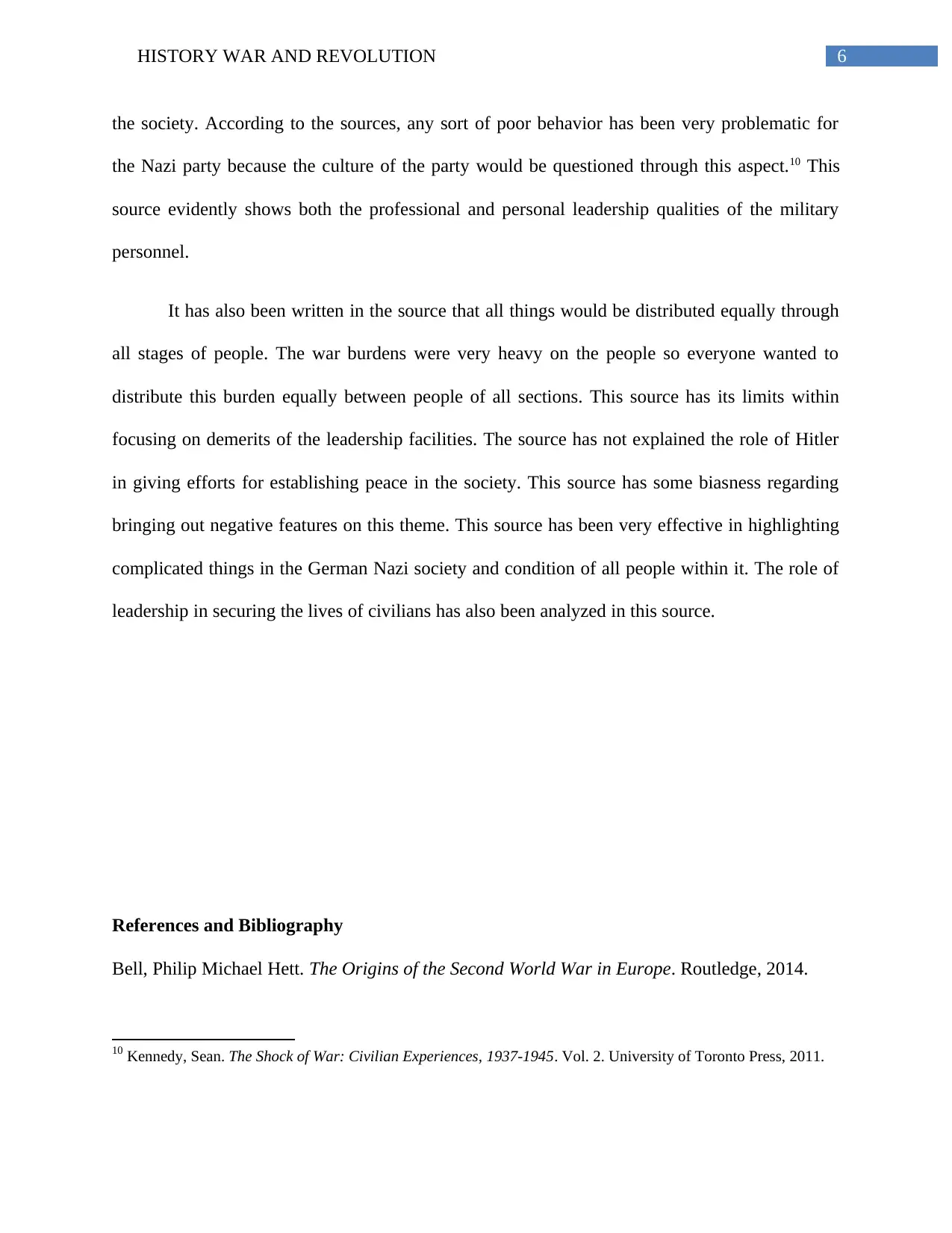
6HISTORY WAR AND REVOLUTION
the society. According to the sources, any sort of poor behavior has been very problematic for
the Nazi party because the culture of the party would be questioned through this aspect.10 This
source evidently shows both the professional and personal leadership qualities of the military
personnel.
It has also been written in the source that all things would be distributed equally through
all stages of people. The war burdens were very heavy on the people so everyone wanted to
distribute this burden equally between people of all sections. This source has its limits within
focusing on demerits of the leadership facilities. The source has not explained the role of Hitler
in giving efforts for establishing peace in the society. This source has some biasness regarding
bringing out negative features on this theme. This source has been very effective in highlighting
complicated things in the German Nazi society and condition of all people within it. The role of
leadership in securing the lives of civilians has also been analyzed in this source.
References and Bibliography
Bell, Philip Michael Hett. The Origins of the Second World War in Europe. Routledge, 2014.
10 Kennedy, Sean. The Shock of War: Civilian Experiences, 1937-1945. Vol. 2. University of Toronto Press, 2011.
the society. According to the sources, any sort of poor behavior has been very problematic for
the Nazi party because the culture of the party would be questioned through this aspect.10 This
source evidently shows both the professional and personal leadership qualities of the military
personnel.
It has also been written in the source that all things would be distributed equally through
all stages of people. The war burdens were very heavy on the people so everyone wanted to
distribute this burden equally between people of all sections. This source has its limits within
focusing on demerits of the leadership facilities. The source has not explained the role of Hitler
in giving efforts for establishing peace in the society. This source has some biasness regarding
bringing out negative features on this theme. This source has been very effective in highlighting
complicated things in the German Nazi society and condition of all people within it. The role of
leadership in securing the lives of civilians has also been analyzed in this source.
References and Bibliography
Bell, Philip Michael Hett. The Origins of the Second World War in Europe. Routledge, 2014.
10 Kennedy, Sean. The Shock of War: Civilian Experiences, 1937-1945. Vol. 2. University of Toronto Press, 2011.
Paraphrase This Document
Need a fresh take? Get an instant paraphrase of this document with our AI Paraphraser
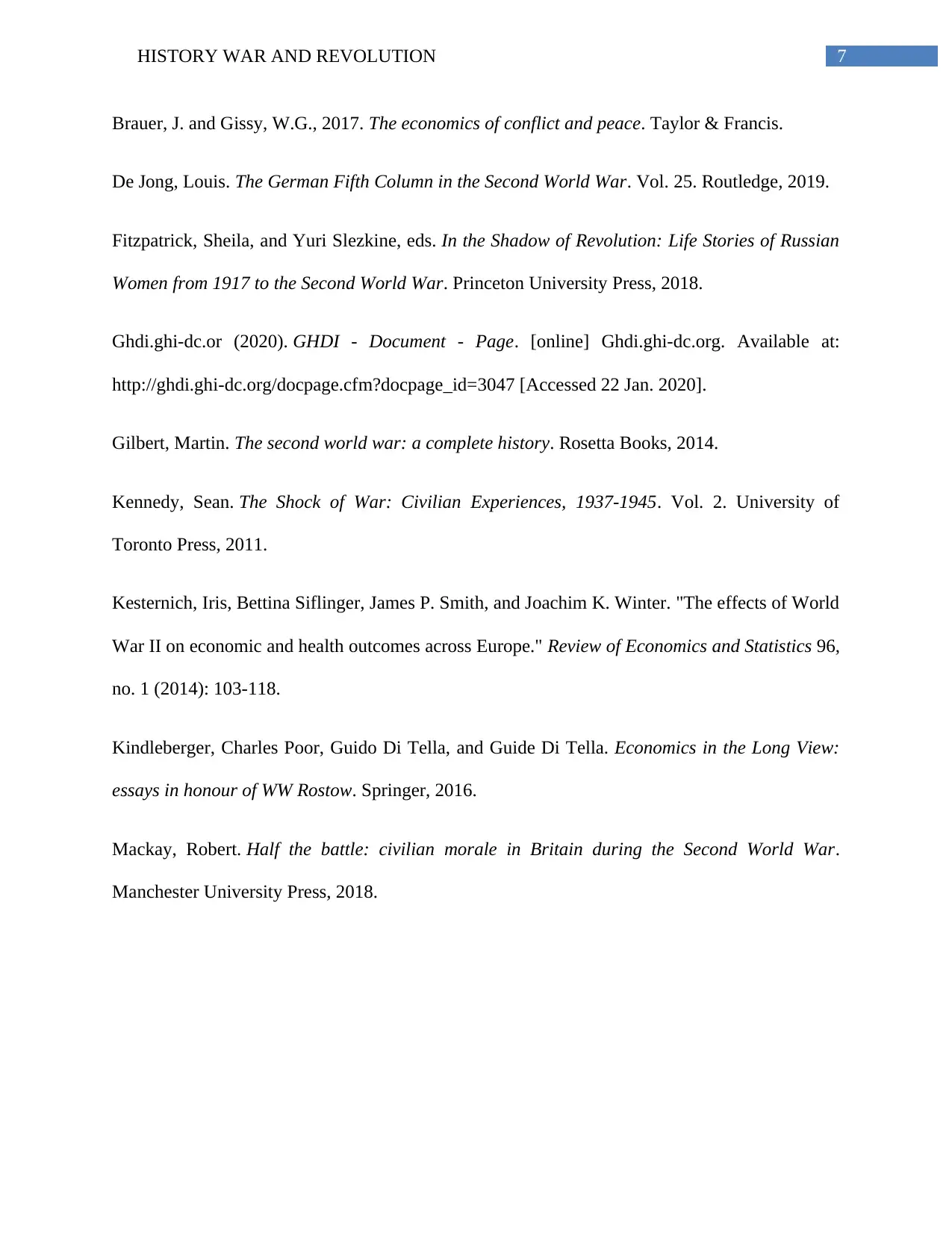
7HISTORY WAR AND REVOLUTION
Brauer, J. and Gissy, W.G., 2017. The economics of conflict and peace. Taylor & Francis.
De Jong, Louis. The German Fifth Column in the Second World War. Vol. 25. Routledge, 2019.
Fitzpatrick, Sheila, and Yuri Slezkine, eds. In the Shadow of Revolution: Life Stories of Russian
Women from 1917 to the Second World War. Princeton University Press, 2018.
Ghdi.ghi-dc.or (2020). GHDI - Document - Page. [online] Ghdi.ghi-dc.org. Available at:
http://ghdi.ghi-dc.org/docpage.cfm?docpage_id=3047 [Accessed 22 Jan. 2020].
Gilbert, Martin. The second world war: a complete history. Rosetta Books, 2014.
Kennedy, Sean. The Shock of War: Civilian Experiences, 1937-1945. Vol. 2. University of
Toronto Press, 2011.
Kesternich, Iris, Bettina Siflinger, James P. Smith, and Joachim K. Winter. "The effects of World
War II on economic and health outcomes across Europe." Review of Economics and Statistics 96,
no. 1 (2014): 103-118.
Kindleberger, Charles Poor, Guido Di Tella, and Guide Di Tella. Economics in the Long View:
essays in honour of WW Rostow. Springer, 2016.
Mackay, Robert. Half the battle: civilian morale in Britain during the Second World War.
Manchester University Press, 2018.
Brauer, J. and Gissy, W.G., 2017. The economics of conflict and peace. Taylor & Francis.
De Jong, Louis. The German Fifth Column in the Second World War. Vol. 25. Routledge, 2019.
Fitzpatrick, Sheila, and Yuri Slezkine, eds. In the Shadow of Revolution: Life Stories of Russian
Women from 1917 to the Second World War. Princeton University Press, 2018.
Ghdi.ghi-dc.or (2020). GHDI - Document - Page. [online] Ghdi.ghi-dc.org. Available at:
http://ghdi.ghi-dc.org/docpage.cfm?docpage_id=3047 [Accessed 22 Jan. 2020].
Gilbert, Martin. The second world war: a complete history. Rosetta Books, 2014.
Kennedy, Sean. The Shock of War: Civilian Experiences, 1937-1945. Vol. 2. University of
Toronto Press, 2011.
Kesternich, Iris, Bettina Siflinger, James P. Smith, and Joachim K. Winter. "The effects of World
War II on economic and health outcomes across Europe." Review of Economics and Statistics 96,
no. 1 (2014): 103-118.
Kindleberger, Charles Poor, Guido Di Tella, and Guide Di Tella. Economics in the Long View:
essays in honour of WW Rostow. Springer, 2016.
Mackay, Robert. Half the battle: civilian morale in Britain during the Second World War.
Manchester University Press, 2018.
1 out of 8
Related Documents
Your All-in-One AI-Powered Toolkit for Academic Success.
+13062052269
info@desklib.com
Available 24*7 on WhatsApp / Email
![[object Object]](/_next/static/media/star-bottom.7253800d.svg)
Unlock your academic potential
Copyright © 2020–2025 A2Z Services. All Rights Reserved. Developed and managed by ZUCOL.





